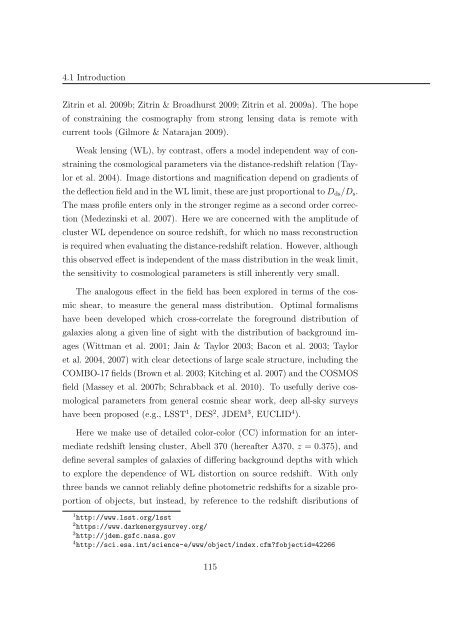Mass and Light distributions in Clusters of Galaxies - Henry A ...
Mass and Light distributions in Clusters of Galaxies - Henry A ...
Mass and Light distributions in Clusters of Galaxies - Henry A ...
Create successful ePaper yourself
Turn your PDF publications into a flip-book with our unique Google optimized e-Paper software.
4.1 Introduction<br />
Zitr<strong>in</strong> et al. 2009b; Zitr<strong>in</strong> & Broadhurst 2009; Zitr<strong>in</strong> et al. 2009a). The hope<br />
<strong>of</strong> constra<strong>in</strong><strong>in</strong>g the cosmography from strong lens<strong>in</strong>g data is remote with<br />
current tools (Gilmore & Natarajan 2009).<br />
Weak lens<strong>in</strong>g (WL), by contrast, <strong>of</strong>fers a model <strong>in</strong>dependent way <strong>of</strong> constra<strong>in</strong><strong>in</strong>g<br />
the cosmological parameters via the distance-redshift relation (Taylor<br />
et al. 2004). Image distortions <strong>and</strong> magnification depend on gradients <strong>of</strong><br />
the deflection field <strong>and</strong> <strong>in</strong> the WL limit, these are just proportional to D ds /D s .<br />
The mass pr<strong>of</strong>ile enters only <strong>in</strong> the stronger regime as a second order correction<br />
(Medez<strong>in</strong>ski et al. 2007). Here we are concerned with the amplitude <strong>of</strong><br />
cluster WL dependence on source redshift, for which no mass reconstruction<br />
is required when evaluat<strong>in</strong>g the distance-redshift relation. However, although<br />
this observed effect is <strong>in</strong>dependent <strong>of</strong> the mass distribution <strong>in</strong> the weak limit,<br />
the sensitivity to cosmological parameters is still <strong>in</strong>herently very small.<br />
The analogous effect <strong>in</strong> the field has been explored <strong>in</strong> terms <strong>of</strong> the cosmic<br />
shear, to measure the general mass distribution. Optimal formalisms<br />
have been developed which cross-correlate the foreground distribution <strong>of</strong><br />
galaxies along a given l<strong>in</strong>e <strong>of</strong> sight with the distribution <strong>of</strong> background images<br />
(Wittman et al. 2001; Ja<strong>in</strong> & Taylor 2003; Bacon et al. 2003; Taylor<br />
et al. 2004, 2007) with clear detections <strong>of</strong> large scale structure, <strong>in</strong>clud<strong>in</strong>g the<br />
COMBO-17 fields (Brown et al. 2003; Kitch<strong>in</strong>g et al. 2007) <strong>and</strong> the COSMOS<br />
field (<strong>Mass</strong>ey et al. 2007b; Schrabback et al. 2010). To usefully derive cosmological<br />
parameters from general cosmic shear work, deep all-sky surveys<br />
have been proposed (e.g., LSST 1 , DES 2 , JDEM 3 , EUCLID 4 ).<br />
Here we make use <strong>of</strong> detailed color-color (CC) <strong>in</strong>formation for an <strong>in</strong>termediate<br />
redshift lens<strong>in</strong>g cluster, Abell 370 (hereafter A370, z = 0.375), <strong>and</strong><br />
def<strong>in</strong>e several samples <strong>of</strong> galaxies <strong>of</strong> differ<strong>in</strong>g background depths with which<br />
to explore the dependence <strong>of</strong> WL distortion on source redshift. With only<br />
three b<strong>and</strong>s we cannot reliably def<strong>in</strong>e photometric redshifts for a sizable proportion<br />
<strong>of</strong> objects, but <strong>in</strong>stead, by reference to the redshift disributions <strong>of</strong><br />
1 http://www.lsst.org/lsst<br />
2 https://www.darkenergysurvey.org/<br />
3 http://jdem.gsfc.nasa.gov<br />
4 http://sci.esa.<strong>in</strong>t/science-e/www/object/<strong>in</strong>dex.cfm?fobjectid=42266<br />
115
















